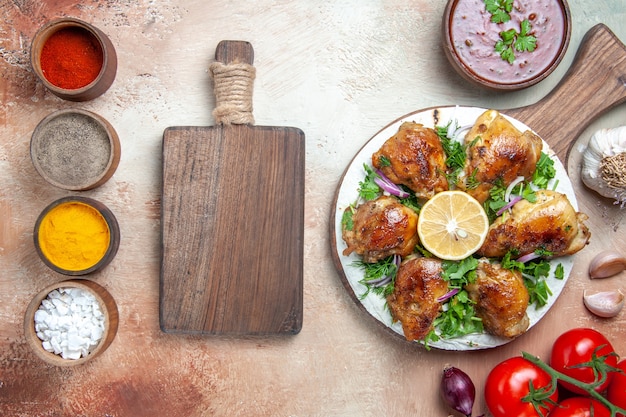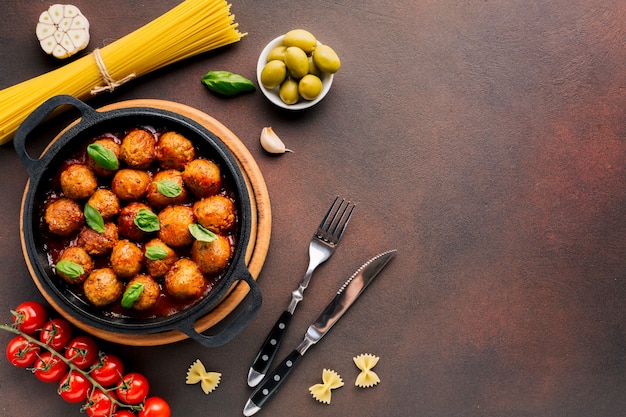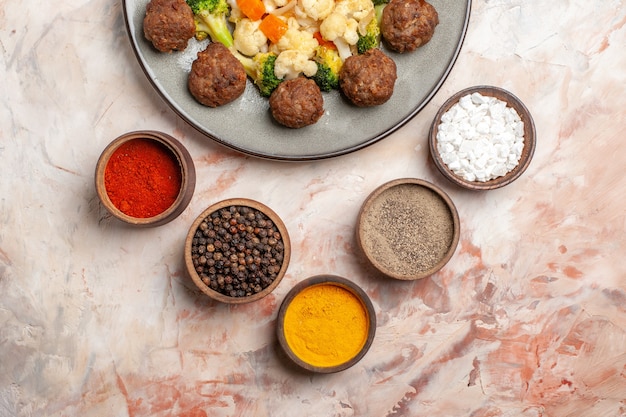Let's face it, who doesn't love a good meatball? They're the ultimate comfort food, a symphony of textures and flavors that always hits the spot. From the comforting aroma that fills the kitchen as they simmer in their sauce to the satisfying bite of a perfectly cooked, juicy morsel, meatballs hold a special place in our hearts. I've been a self-proclaimed meatball enthusiast for as long as I can remember, and over the years, I've spent countless hours experimenting with recipes, techniques, and flavor combinations. I've had my fair share of dry, crumbly disasters (we've all been there!), but I've also stumbled upon the secrets to achieving meatball nirvana.
So, whether you're a seasoned meatball pro or a complete novice, get ready for a deep dive into the world of meatballs. We'll explore everything from the perfect blend of ingredients to the most effective cooking methods, uncovering the secrets to creating juicy, flavorful perfection. We'll unravel the mysteries of achieving that sought-after tender texture, explore a variety of flavor profiles, and equip you with the knowledge to create meatballs that will have your family and friends begging for more.
(Part 1) The Foundation of a Great Meatball: Ingredients

The Meat: Choosing the Perfect Blend
The heart and soul of any meatball lies in the meat itself. While there are no strict rules, the best meatballs are typically made with a combination of ground meats. My personal preference is a mix of beef and pork, which creates a rich, savory flavor with a beautiful texture. But don't be afraid to get creative! You can experiment with lamb, veal, chicken, or even a mix of different types of sausage, depending on your taste preferences.
The key is to choose meats that are finely ground, ensuring your meatballs hold together well and cook evenly. If you're using a meat grinder, aim for a medium grind. Don't be afraid to ask your butcher for their recommendations!
The Binder: Holding It All Together
Breadcrumbs are a classic binder for meatballs, absorbing excess moisture and providing structure. I prefer using dried breadcrumbs, which tend to be a bit more absorbent and give a slightly crispier texture. However, fresh breadcrumbs will work perfectly fine, just make sure they're finely ground. Some people also swear by grated Parmesan cheese as a binder, which adds a lovely salty flavor and a touch of richness to the meatballs.
The Liquid: Adding Moisture and Tenderness
Adding a bit of liquid to your meatball mixture is essential for achieving a juicy, tender texture. My go-to is milk, which adds a touch of creaminess and helps to prevent the meatballs from becoming dry. However, you can also use water, broth, or even beer, depending on the flavor profile you're going for. Just a few tablespoons will do the trick.
The Seasoning: A Symphony of Flavors
Here's where you can really unleash your creativity! Salt and pepper are the essential base, but don't be afraid to go beyond the basics. Garlic, onion powder, oregano, parsley, paprika, and even a touch of cayenne pepper can elevate your meatballs to new heights. For a classic Italian flavor, you can add a pinch of red pepper flakes or a sprig of fresh basil.
Experiment with different herb and spice combinations to discover your favorite flavor profiles. The possibilities are endless!
(Part 2) Achieving Meatball Perfection: Mixing and Shaping

The Art of Mixing: Gentle Handling for Tender Meatballs
Once you've assembled your ingredients, it's time to create the magic. The key here is to avoid overmixing! Overmixing develops the gluten in the meat, resulting in tough, chewy meatballs. Instead, use a light touch, gently combining the ingredients until just combined.
I find it helpful to use my hands, allowing me to feel the texture of the mixture and ensure everything is evenly distributed. However, if you prefer, you can use a large spoon or spatula. Just remember, the goal is to create a homogeneous mixture without overworking the meat.
Shaping Your Meatballs: Achieving Uniformity and Elegance
Now comes the fun part – shaping your meatballs! You can use a spoon to scoop out portions of the mixture and roll them into balls. For perfectly sized meatballs, I recommend using a cookie scoop. This will give you uniform, even-sized meatballs, which will cook more evenly and consistently.
If you're feeling fancy, you can also use a meatball maker to shape your meatballs. This tool can create beautiful, round meatballs with a smooth finish, perfect for a special occasion or when you want to impress your guests.
(Part 3) The Magic of the Sauce: A Journey through Flavour

Choosing Your Sauce: A Spectrum of Flavor Possibilities
The beauty of meatballs lies in their versatility. They pair beautifully with a wide range of sauces, from classic Italian marinara to creamy Alfredo and even tangy tomato-based sauces with a hint of chili.
For a classic Italian flavor, you can’t go wrong with a simple marinara sauce made with tomatoes, onions, garlic, herbs, and a touch of sugar. But if you're feeling adventurous, consider experimenting with a more complex sauce, like a rich ragu, which simmered for hours with red wine and a variety of vegetables, or a creamy pesto sauce, made with fresh basil, pine nuts, and Parmesan cheese.
The Sauce-Making Process: From Simple to Complex
Whether you're using a store-bought sauce or making your own from scratch, the sauce is a crucial element in creating delicious meatballs. If you’re making your sauce from scratch, start by sautéing your aromatics – onions, garlic, and herbs – in olive oil until fragrant. Then, add your crushed tomatoes and simmer the sauce for at least 30 minutes, allowing the flavours to develop.
For a richer sauce, you can add a splash of red wine or a dollop of tomato paste. Don’t be afraid to experiment with different seasonings to create a sauce that reflects your unique taste.
(Part 4) Cooking Methods: Exploring the Options
The Classic oven method: A Reliable and Foolproof Technique
This is a reliable and foolproof method for cooking meatballs. Preheat your oven to 375°F (190°C) and line a baking sheet with parchment paper or foil. Arrange your meatballs on the baking sheet, leaving a little space between each one to allow for even cooking.
For extra flavor, you can brush the meatballs with a little olive oil or a mixture of olive oil and balsamic vinegar before baking. Bake for 20-25 minutes, or until the meatballs are cooked through.
The Pan-Frying Method: Achieving a Crispy Exterior and Juicy Interior
This method is great for achieving a crispy exterior and a juicy interior. Heat a large skillet over medium heat and add a little olive oil. Carefully add the meatballs to the skillet, leaving some space between each one. Cook the meatballs for about 5-7 minutes per side, or until golden brown and cooked through.
For a richer flavour, you can deglaze the pan with a little red wine or broth after cooking the meatballs. Just scrape up any browned bits from the bottom of the pan, then simmer the sauce for a few minutes to thicken it.
The slow cooker method: A Hands-Off Approach for Maximum Flavor
This is a great option if you’re looking for a hands-off method. Coat the bottom of your slow cooker with a thin layer of your sauce. Add the meatballs, making sure they’re evenly spaced. Pour the rest of the sauce over the meatballs.
Cook on low for 4-6 hours, or until the meatballs are cooked through and the sauce has thickened. The slow cooker method allows the flavours to meld and create a truly delicious meal.
(Part 5) Serving Up the Perfect Meatball: A Celebration of Flavour
Accompanying Dishes: Complementary Sides for a Delicious Meal
Meatballs are incredibly versatile and pair well with a variety of side dishes. For a classic Italian vibe, serve your meatballs with a side of spaghetti, linguini, or rigatoni. You can also opt for a more rustic approach with crusty bread or polenta.
If you're feeling creative, you can even serve your meatballs over a bed of rice, quinoa, or mashed potatoes. The options are truly endless!
Garnish for a Touch of Elegance: Adding the Finishing Touches
A simple garnish can elevate your meatballs from good to great. Consider adding a sprinkle of fresh parsley, a drizzle of olive oil, or a few grated parmesan shavings. You can even add a dollop of sour cream or ricotta cheese to add a touch of creaminess.
Don't forget the importance of presentation! Use a beautiful serving platter or a rustic wooden board to showcase your delicious meatballs.
(Part 6) Beyond the Basics: Exploring the World of meatball variations
Spicy Meatballs: Adding a Kick to Your Meal
For those who love a kick, you can add a touch of heat to your meatballs. Use a combination of spices like cayenne pepper, chili powder, and paprika to add a fiery flavour. You can also incorporate jalape??os or other spicy peppers into your meatball mixture.
Mediterranean Meatballs: Transporting Your Taste Buds to Sunny Shores
Transport your taste buds to the sun-drenched shores of the Mediterranean with these flavourful meatballs. Use a combination of ground lamb, feta cheese, and herbs like oregano, thyme, and rosemary to create a truly authentic taste.
asian-inspired meatballs: Embracing the Vibrant Flavors of the East
Embrace the vibrant flavours of Asian cuisine with these unique meatballs. Combine ground pork or chicken with ingredients like soy sauce, ginger, garlic, and sesame oil for a fragrant and flavourful result. Serve with a dipping sauce made with sweet chili sauce or teriyaki sauce.
(Part 7) meatball mastery: Tips and Tricks for Success
Here are some tips and tricks I've picked up over the years to ensure your meatballs turn out perfectly every time:
- Chill the meatball mixture before shaping: Chill the mixture in the refrigerator for at least 30 minutes. This will help the meatballs hold their shape during cooking and prevent them from becoming overly mushy.
- Don't overcook: Overcooked meatballs can become dry and tough. Cook them until they’re cooked through but still moist and juicy. A meat thermometer is a helpful tool for ensuring proper doneness.
- Use a meat thermometer: To ensure the meatballs are cooked thoroughly, use a meat thermometer to check the internal temperature. The internal temperature should reach 160°F (71°C).
- Add a splash of red wine: Deglazing your pan with a splash of red wine after cooking your meatballs will add a delicious depth of flavor to your sauce. The wine will help to loosen any browned bits from the bottom of the pan, creating a rich and flavorful sauce.
- Don’t be afraid to experiment: The beauty of meatballs lies in their versatility. Experiment with different flavour combinations and cooking methods to find what you love best! Don't be afraid to try new things and embrace your creativity in the kitchen.
(Part 8) A Meatball Journey Through History
Did you know that meatballs have a long and fascinating history? The earliest known versions of meatballs were probably made by early hunter-gatherers who would have ground up meat and mixed it with other ingredients before cooking it over an open fire.
Over time, meatballs have evolved and adapted to different cultures and cuisines. In ancient Rome, they were a staple food, and they continue to be a popular dish in many parts of the world today.
Here's a brief glimpse into the history of meatballs around the world:
| Region | Meatball Variation | Description |
|---|---|---|
| Italy | Polpette | classic italian meatballs, often made with beef and pork, and served with a tomato-based sauce. They are typically larger in size and have a slightly crumbly texture. |
| Greece | Keftes | Ground lamb meatballs seasoned with herbs like oregano, thyme, and mint. These meatballs are typically smaller and more compact, often served with a yogurt sauce or tzatziki. |
| Sweden | K??tbullar | Swedish meatballs, typically made with beef and pork, and served with a creamy white sauce and mashed potatoes. They are known for their delicate flavor and smooth texture, often paired with lingonberry sauce. |
| China | Lion's Head Meatballs | Large meatballs made with pork and served in a sweet and savory sauce. These meatballs are traditionally made with a combination of ground pork and fatback, resulting in a tender and flavorful meatball. |
The story of meatballs is a testament to the enduring power of simple food. They’ve crossed borders, cultures, and centuries, offering comfort, flavour, and a taste of home, wherever you may be.
(Part 9) Meatball Masterclass: FAQs
Here are some frequently asked questions about meatballs:
- What’s the best way to prevent my meatballs from falling apart?
The secret lies in a combination of factors. First, use a good binder, such as breadcrumbs or grated Parmesan cheese. Second, don't overmix the meatball mixture. Third, chill the mixture in the refrigerator for at least 30 minutes before shaping. This allows the binder to absorb excess moisture and firm up the mixture, making the meatballs less prone to falling apart during cooking. Finally, don't overcook the meatballs, as this can also cause them to become dry and crumble.
- How do I know if my meatballs are cooked through?
The best way to ensure your meatballs are cooked through is to use a meat thermometer. The internal temperature should reach 160°F (71°C). However, if you don't have a meat thermometer, you can also check the meatballs for doneness by cutting one in half. The centre should be cooked through and no longer pink. You can also check the texture of the meatballs – they should be firm to the touch and not feel mushy or raw in the centre.
- Can I freeze meatballs?
Yes, you can freeze meatballs. Place them in a freezer-safe bag or container and freeze for up to 3 months. To cook frozen meatballs, thaw them in the refrigerator overnight or cook them directly from frozen in the oven or slow cooker.
- What's the best way to reheat meatballs?
You can reheat meatballs in the oven, microwave, or on the stovetop. To reheat in the oven, preheat the oven to 350°F (175°C) and place the meatballs on a baking sheet. Bake for 15-20 minutes, or until heated through. To reheat in the microwave, place the meatballs on a microwave-safe plate and microwave on high for 30 seconds to 1 minute, or until heated through. To reheat on the stovetop, heat a little olive oil in a skillet over medium heat and add the meatballs. Cook for 5-7 minutes, or until heated through.
- Can I make vegetarian meatballs?
Absolutely! There are many delicious vegetarian meatball recipes available. Common ingredients for vegetarian meatballs include lentils, chickpeas, quinoa, or breadcrumbs. You can also add spices, herbs, and vegetables to create flavorful and satisfying vegetarian meatballs.
I hope this comprehensive guide has inspired you to embark on your own meatball adventures. Remember, there’s no right or wrong way to make meatballs, so feel free to experiment, explore different flavours, and create your own unique meatball masterpiece. Bon appétit!
Everyone is watching

How to Cook Frozen Lobster Tails Perfectly: A Step-by-Step Guide
RecipesLobster. Just the word conjures up images of lavish meals, special occasions, and a taste of luxury. But let's...

Pigs in a Blanket Cooking Time: How Long to Bake for Perfect Results
RecipesAh, pigs in a blanket. Just the name conjures up images of those delightful little parcels of crispy pastry en...

Pork Fillet Cooking Time: How Long to Cook It Perfectly
RecipesPork fillet, or tenderloin as it's sometimes called, is a real favourite in our house. It's so versatile, and...

The Ultimate Guide to Cooking Delicious Frankfurters
RecipesLet's face it, we all love a good frankfurter. It's a classic, simple, and always satisfying. But let's be rea...

Wolf Meat Recipes: A Guide to Cooking Wild Game
RecipesLet's be honest, you don't see wolf meat at your local butcher shop every day. It's a bit of a wild card, but ...
